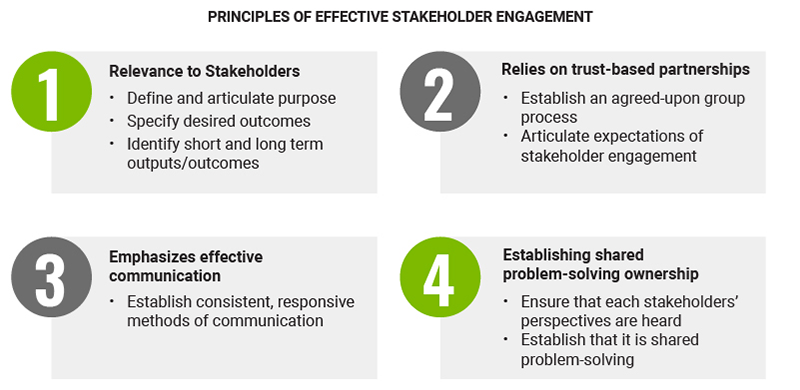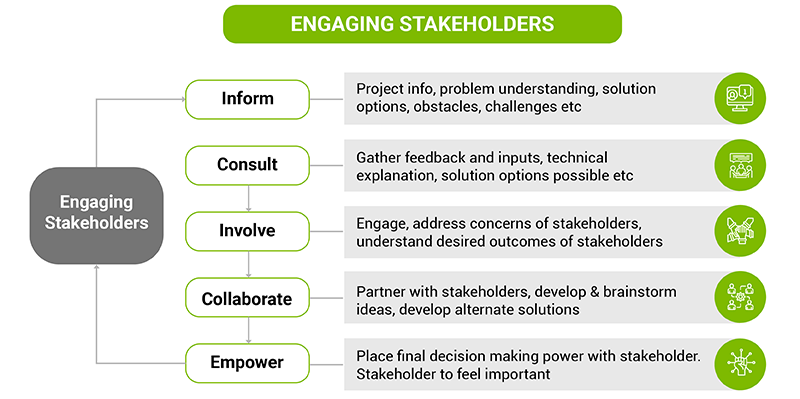An Approach To Impactful Stakeholder Consultations

Stakeholder engagement is critical for many projects, activities, and organizations’ impactful and significant success. It helps capture the views and perceptions of people who may impact the project work. At AEEE, we also consider it essential to gain validation from industry experts and stalwarts on our work, such as verifying facts and data. Furthermore, it helps people on the project understand their roles and responsibilities concerning a project or commitment. Most projects or programs devise a work plan inclusive of stakeholder consultation and strategically mapping their cross-sectoral skills that correlate with the activities. A well-planned consultation allows us to personally identify their strengths and pulse on their expertise to enable future collaborations and projects to withstand long-term professional relationships. Most importantly, interacting with such experts brings transparency and trust to our line of work, which is critical for the project’s success and sustenance and overarchingly aligns with the industry, policymakers, and other stakeholders.
In this blog, we will explore the following:
- When does one need a stakeholder consultation?
- Significance of stakeholder consultation.
- How to identify the right stakeholder?
- How to approach a stakeholder?
- Some etiquettes to keep in mind while engaging with a stakeholder
Stakeholders are those who have a ‘stake’ in the outcome of a project. They can be internal or external to an organization or agency, as depicted in Figure 1. Internal stakeholders include our peer employees, managers, shareholders, board of directors, etc. External stakeholders are usually external to our work environments, such as industry professionals, community voices, subject matter experts, government and regulatory bodies, etc. Both internal and external stakeholders help decode a particular line of activity’s impact on others or the overall system and ensure to consider all perspectives. This is especially true when consulting experts for a specific line of work. In our context of a low-carbon built environment, we identify stakeholders internally or externally for different lines of work, such as green building consultants, policymakers, architects, building developers, and academicians. Determining who fits where and for which project is crucial to ensuring a successful stakeholder consultation. They are pivotal in offering feedback and assistance as a project progresses.
 Figure 1 Internal & External stakeholders
Figure 1 Internal & External stakeholders
Significance of stakeholder engagements
Soliciting input from stakeholders promotes buy-in and ensures an understanding of different perspectives. Diverse groups often provide creative solutions to critical issues and lead to strategies that create meaningful results for all parties involved in, or served by, an initiative. In addition, solving problems for a common cause and broadening the reach of efforts to create positive outcomes brings tremendous satisfaction to everyone involved in the process, leading to more effective implementation and long-term sustainability of projects. For these reasons, project teams consult stakeholders to get insights on various system-level initiatives.
Principles of effective stakeholder engagement
Four core principles guide effective stakeholder engagement. When applied effectively, these principles, as illustrated in Figure 2, lead to stakeholder buy-in, shared problem-solving, trust-based relationships, and increased accountability. These principles will lead to an efficient, collaborative stakeholder process that achieves better outcomes.
 Figure 2 Principles of effective stakeholder engagement
Figure 2 Principles of effective stakeholder engagement
- The first principle emphasizes the importance of leaders ensuring that the initiative, project, work team, or committee is relevant to the stakeholders. This includes clearly defining and articulating the purpose of work to be done in meaningful ways to the stakeholders. Examples: “The purpose of this stakeholder engagement is to ….”“The outcome of all consultations will be collated in a format such that….”
- The second principle highlights the importance of relationships in the stakeholder engagement process. Establishing an agreed-upon group process and clearly articulating expectations for stakeholder engagement help all participants understand the nature of the consultation, their role, and the expected outcome. Examples: “We know that our team has already held stakeholder consultations with you for our past projects, and we find your contribution invaluable in terms of….”“At the end of this consultation, we mainly intend to have answers for these main questions- (1)…..(2)….(3)…. as already shared with you over email.”
- The third principle emphasizes effective communication throughout the stakeholder engagement process. Effective communication must be consistent, responsive, and reflect stakeholders’ needs and expectations. It also needs to ensure that any conflicts are effectively addressed and acknowledged. Examples: “Yes, I agree with that point.” “Yes, we have faced similar issues in the past”; “Our other consultants have also provided a similar response. It must be the need of the hour, as you rightly mentioned”; “As you earlier talked about xxx, could you elaborate more on that.”
- The fourth principle highlights the importance of establishing shared problem-solving ownership during stakeholder engagement and group processes. Leaders of stakeholder groups should emphasize the importance of shared problem-solving by ensuring that each stakeholder’s opinion, information, and ideas are shared and heard. Practical problem-solving involves timely, reflective, flexible, and responsive decision-making. Examples: “Let me first explain our approach of a stakeholder consultation to give you an idea of the scale and process of our internal analysis and further deriving key outcomes…”;”As you earlier talked about xxx, could you elaborate more on that”; “We agree that this is a challenge. We are making a note of that as part of the challenges section”.
Identifying- ‘When do we need a stakeholder consultation.’
Most of us are aware of and agree with the significance of stakeholder consultation. The best time to solicit feedback on our efforts is critical to identify. It is natural to have concerns about disagreements, extra project time and costs, and delays in planning and implementation. Thus, project teams must meticulously chalk out project planning and timelines, so delays or inadequate consultation do not become bottlenecks. Setting up a specific time frame for stakeholder engagement within a work plan and commencing it as late as possible to ensure project completion is a frequent mistake that most teams make.
During a project, one can plan different levels of stakeholder engagement right from the inception stage, as shown in Figure 3. We need not dive deep into discussions at this point. We can start by identifying our stakeholders and providing them with basic information on the project – its aim, objective, methodology, and impact – and discuss possible solutions to reach the end goal. At this stage, external validation aids in more systematically framing the problem. Then, we can begin soliciting input on the data through consultation to prioritize the pressing issue at hand jointly. At this stage, we will be confident while answering these three critical questions –
- Why is the problem at hand significant?
- What can we do to solve it?
- How can we execute the solution?
While finding answers to these questions, we might need to go back to some people for data and statistics.
The next stage is the analysis stage. At this point, we need to collaborate with the stakeholders as there will be a lot of decision-making, including coming up with alternative solutions and deciding on the optimal option collectively. The underlying goal is to achieve consensus regarding decisions. Now, we try to give some final decisions to our most important stakeholder groups throughout the project’s closing stages to give them more authority.
 Figure 3 The 7-step consulting framework (Source: 180Degrees Consulting) edited by the authors
Figure 3 The 7-step consulting framework (Source: 180Degrees Consulting) edited by the authors
Identifying the right stakeholders
A diverse collection of stakeholders ensures to consider all viewpoints as the group moves forward. It is critical for the project or initiative leader to ensure not to overlook essential perspectives and to change the stakeholder group in ways that promote complete and timely decision-making. Stakeholder involvement is only as good as the leadership that chooses the appropriate stakeholders to participate in the group’s activities. The group’s goals, advantages, and anticipated outcomes determine who should join as stakeholders.
 Figure 4 Influence vs Engagement level matrix (Source: Authors)
Figure 4 Influence vs Engagement level matrix (Source: Authors)
One must cautiously identify and decide on the right stakeholder, a crucial process during the initial decision-making stages. The team must then determine the nature of the stakeholder based on the project requirements. This can be mapped in the following matrix, as shown in Figure 4, to lay out the goals and intent of the stakeholder consultation. For instance, we can seek a stakeholder with substantial influence and engagement levels (quadrant-1) if the project requires guidance, critical thinking, identifying improvement areas, and improving associations and networking. If the condition is only technical support with existing associations, a stakeholder with low influence and engagement levels (quadrant-4) will suffice.
Engaging stakeholders during the consultation
After identifying the appropriate type of stakeholder and mapping them under the influence-engagement graph, one must lay down a detailed approach for involving stakeholders during the consultation. As shown in Figure 5, the engagement of stakeholders begins with informing the stakeholder about the project, like the project information, problem understanding, solution options, obstacles, challenges, etc. The second step is to consult by gathering feedback, inputs, technical explanation, etc. The third step is active questioning, communication, understanding stakeholders’ desired outcomes, etc. The fourth step is to collaborate by partnering with other experts and stakeholders, develop & brainstorm ideas and develop alternate solutions. The fifth and final step is to empower the stakeholder by placing the absolute decision-making power with the stakeholder in alignment with the project team after arriving at a mutual conclusion during the stakeholder consultation.
 Figure 5 Engaging stakeholders
Figure 5 Engaging stakeholders
Etiquettes of stakeholder consultations
Studies show that human behavioral patterns and etiquettes impact almost every aspect of the planet. Therefore, multiple etiquettes must be followed before, during, and after stakeholder consultations for impactful communication to ensure justice to the opportunity. Some important etiquettes are as follows:
- Schedule the meeting beforehand and mention the session’s agenda, date, time, duration, and expectations.
- In the case of in-person meetings, punctuality, presentability, and preparedness, in conjunction with appropriate supporting documents and resources, are very important.
- In the case of virtual meetings, ensuring audio and video clarity and having the videos on is an essential etiquette.
- Body language during meetings (in-person or virtual) is another crucial etiquette that one must pay attention to, as it directly reflects one’s thoughts and actions.
- Clarifying any communication with the stakeholder needs to be done systematically. Rephrasing and repeating sentences verbatim to confirm one’s understanding is one way of clarification that indirectly guarantees that the stakeholders’ insights are heard. Listening more than speaking can be another way of avoiding miscommunications.
- Most importantly, updating the stakeholder consulted regarding essential project updates, events, releases, and launches is vital. Additionally, project teams must acknowledge the stakeholders through appropriate mediums like official emails or phone calls based on the project and the stakeholders’ involvement.
References
- https://pressbooks.bccampus.ca/technicalwriting/chapter/stakeholderengagement/
- https://www.b2binternational.com/publications/stakeholder-research/
- https://180dc.org/7stepconsulting/
- https://mymanagementguide.com/stakeholder-engagement-planning-two-steps-for-engaging-stakeholders-in-project-implementation/
- https://www.pmc.gov.au/sites/default/files/publications/best-practice-consultation.pdf
This blog is written by Dharini Sridharan & Aafsha Kansal




